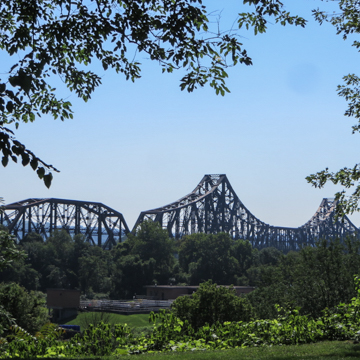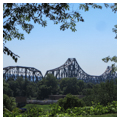The dramatic confluence of the Beaver and the Ohio rivers is a stirring natural spectacle, one that is enhanced by an unparalleled collection of bridges. From the Pittsburgh and Lake Erie Railroad Bridge (P&LE), described soon after it opened in 1910 as an engineering wonder of the century, to the Rochester-Monaca Highway Bridge, the area's six bridges are a visual catalog of twentieth-century bridge types. From the early nineteenth century, bridges spanned the narrower Beaver River and eventually the wider Ohio. By the 1890s, covered wooden bridges were replaced by skeletal iron, then by the steel and concrete spans of today.
The P&LE Bridge ( BE15.1; 1908–1909) was once the world's longest cantilever bridge (1,780 feet). German-educated design engineer Albert Lucius and A. R. Raymer, the railroad's assistant chief engineer, used 17,000 tons of steel to give their double-track steel bridge massive structural strength. At the time, it was criticized as too expensive and stronger than the weight demands of the day's trains, but the bridge continues to bear today's heavier burdens. The two-peaked profile, the long central span cantilevered over the river by the support of its counterbalancing piers, the structural refinement, and sheer visual presence of its blackened steel contrast sharply with the simple curved-outline twin spans of the nearby Conrail Bridge crossing the Beaver River since 1926 ( BE15.2). Both can be viewed from the city of Beaver at the intersection of Beaver Road and East End Avenue or from the riverside park in Rochester at the foot of Water Street.
North of the Conrail Bridge is the Rochester-Beaver Highway Bridge of 1958 (
BE15.3). This modern deck-arch bridge is the major automobile connection to the city of Beaver, and the busiest span in the county. North of it are the three steel trusses of the Rochester–West Bridgewater Bridge (
BE15.4; 1933; see p. 132), a joint project of local
The newest bridge at the confluence, the Rochester-Monaca Highway Bridge of 1986 ( BE15.5) reuses three stone piers and two abutments from an earlier span, and its through arch and flat profile are reminiscent of the long wooden bridges that first spanned the rivers of western Pennsylvania. Since 1988, the winner of the Monaca Indians/Rochester Rams high school football game is allowed to reorder the town names on the bridge's signs. The Monaca–East Rochester Highway Bridge of 1959 ( BE15.6), farther up the Ohio River, is a steel cantilever bridge with a traditional profile and a heavy steel super-structure. It was a toll bridge until 1973.












